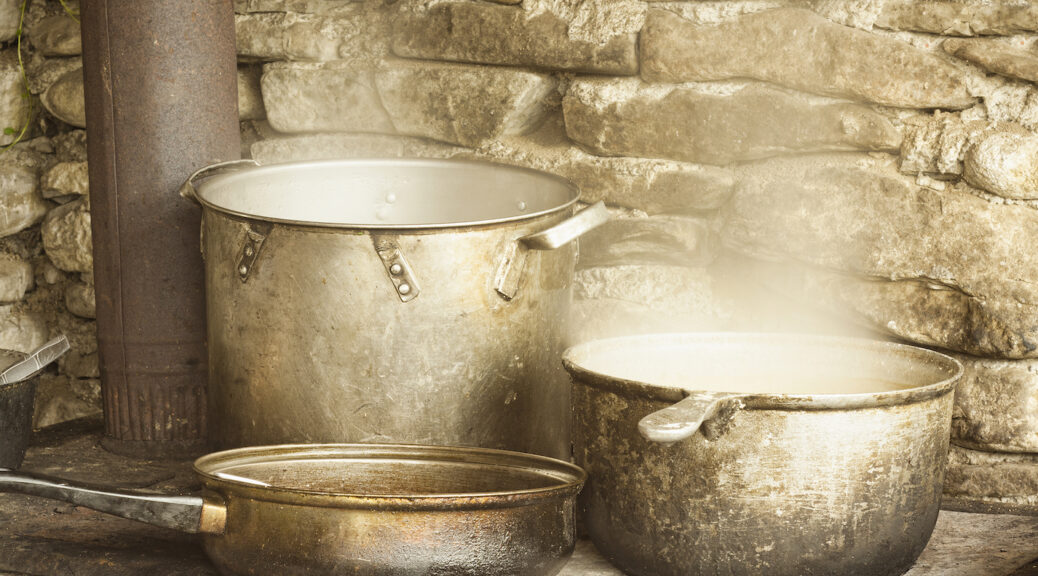
Care of Cook Ware for Wood Burning Stoves
In the 1800s, you had to be careful of your cook ware or it might crack or warp. And if you used copper ware, it might even poison you!
INFORMATION BELOW FROM 1800s COOKBOOKS
NEW OVENS
New ovens, before they are baked, should be heated half a day. The lid should be put up as soon as the wood is taken out. It should not be used for baking until it has been heated the second time. If not treated in this manner, it will never retain the heat well.
IRON WARE
Iron cooking utensils, when new, will be less liable to crack if heated gradually five or six hours, and then cooled slowly.
Boil a double handful of hay or grass in a new iron pot before cooking with it. Scrub out with soap and sand, then fill with water and let it boil again for half an hour. After this, you may use it without fear.
To prevent a new frying pan from warping, wipe with a hot wet cloth, thoroughly dry it, cover the inside of the pan with melted fat, and let it boil gently for two minutes.
Cold water should never be poured into hot iron utensils, as it will crack them by cooling the surface too suddenly.
ALUMINUM WARE
Aluminum ware is best for fruits and general cooking purposes, except for vegetables. Never put lye or anything alkaline into aluminum vessels. Everyone who uses aluminum saucepans know how difficult it is to keep them free from the dark stain that collects inside. Just boil some rhubarb or rhubarb leaves in the stained pan and it will become beautifully clean and white. When rhubarb cannot be obtained, vinegar can do nearly as well and can be used several times over.
COPPER WARE
In domestic economy, the necessity of keeping copper vessels always clean, is generally acknowledged. But it may not be so generally known that fat and oily substances, and vegetable acids, do not attack copper while hot. Therefore, if no liquor is suffered to remain and grow cold in copper vessels, they may be used for every culinary purpose with perfect safety. The object is to clean and dry the vessels well before they turn cold. And copper utensils should be thoroughly cleaned with salt and hot vinegar before being used.
COPPER POISONING
Many serious accidents have been occasioned by the use of copper in kitchen requisites. The eating of fruit especially that has been prepared in a copper stew-pan, where some of the oxide was insensibly imbibed, has been known to produce death; or if coffee grounds are suffered to remain long in a copper coffee-pot, and afterwards mixed with fresh coffee for the sake of economy, the effects will be highly injurious, if not fatal.
The best antidote in such cases is to take immediately a large spoonful of powdered charcoal, mixed with honey, butter, or treacle; and within two hours afterwards, an emetic or a cathartic to expel the poison.
EARTHEN WARE
Brown earthen pans are said to be best for cooking. Acids should never be put into the red earthen ware, as there is a poisonous ingredient in the glazing which the acid takes off. Earthen ware used to bake in will be less liable to crack from the heat if put, before it is used, into a vessel with sufficient cold water to cover it. Then heat it gradually till the water boils. When the vessel is taken from the fire, the water should remain until cold.
TIN WARE
Tin pans are lighter, and more convenient, but are too cold for many purposes. If new tin ware is rubbed over with fresh lard and thoroughly heated in the oven before being used, it will never rust afterward, no matter how much it is put in water.
Put new bread and cake tins into a hot oven and bake them until they look like old ones if you wish your bread and cake to be well done on the bottom and sides.
ENAMEL WARE
If new enamel pans are placed in a pan of water and allowed to come to a boil and then cooled, they will be found to last much longer without burning or cracking.
PREVENT CUTLERY FROM RUSTING
Knives and other steel articles are apt to rust when not cleaned frequently. To prevent it, wrap them tight in coarse brown paper when not in use. Knives and forks should be perfectly free from spots and well polished when not in use. They should also be wrapped up, each one by itself, so as to exclude the air.
CLEANING ADVICE
~~ Silverware that has become tarnished can be made to look like new if permitted to stand in potato water for one hour, then taken out and washed.
~~ As soon as you empty a pot or frying-pan of that which has been cooked in it, fill with hot or cold water (hot is best) and set back upon the fire to scald thoroughly.
~~ The most economical way to remove stains from saucepans, both inside and out, is by rubbing with damp ashes.
~~ If a saucepan becomes burned, simply fill with salt water and leave for twenty-four hours. It can then be readily cleansed.
~~ Never set a vessel in the pot-closet without cleaning and wiping it thoroughly. If grease be left in it, it will grow rancid. If set aside wet, it is apt to rust.
~~ The best thing for cleaning tin ware is common [baking] soda. Dampen a cloth, dip it in the soda, and rub the ware briskly, after which wipe dry. You can also rub tin ware with sifted wood ashes or whitening.
~~ Pie plates that have been baked on many times, are apt to impart an unpleasant taste to pies. It may be remedied by boiling them in ashes and water.
~~ Tins that have become rusty or stained may be cleaned by rubbing well with the cut surface of a raw potato, which has been dipped in a fine cleaning powder. Or you can rub the rusted part well with a green tomato cut in half. Let this remain on the tin for a few minutes. Then wash the article and the rust will have vanished.
~~ Stew-pans especially, should never be used without first washing them out with boiling water, rubbing them well with a dry cloth and a little bran, to clean them from grease and sand, or any bad smell they may have contracted since they were last used. Their covers also must be kept perfectly clean, and well-tinned.
~~ If the tinning of a pan happens to be scorched or blistered, it is best to send it directly to be repaired, to prevent any possible danger arising from the solution of the metal.
Photo from Deposit Photos
=================================================
What pots and pans do you like to cook with? Please leave a comment below.
=================================================
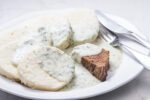
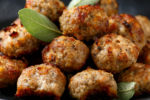
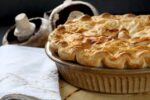
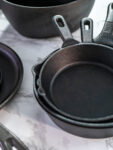
3 thoughts on “Care of Cook Ware for Wood Burning Stoves”
As a docent and re-enactor at a living history landmark I prepare meals over open fire in the fireplace of a late 18th century Kitchen/Keeping room. For safety reasons we use modern cast iron and baking pans that are manufactured to todays safety standards but are replicated to look like “the real thing”. The information on how our great-(or many times great) grandmother’s tackled the cleaning and care of their “tools of the trade” is very revealing. My admiration of these woman for their strengths and ingenuities increases every time I read about their everyday lives, problems and how they coped.
Thank you for providing me with more information and better answers to the questions everyone asks during an open hearth cooking session!
I love going to living history places. I’m from Texas and have visited the farm on the LBJ state park many times. They cook in their kitchen, too, and have authentic kitchen equipment. I believe this farm is from the early 1900s, but it’s still interesting to me.
Good article. I never thought about how much more difficult the pans were to use back then, as if cooking wasn’t already difficult enough. I use heavy stainless steel pans and am glad to not have to worry about all the hot and cold issues and that I have never had to boil a double handful of hay in them before I used them. 🙂 I use glass pans for baking casseroles and the occasional quiche. I don’t bake much of anything else.